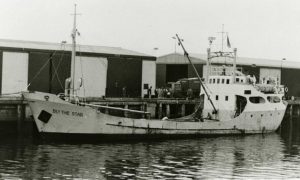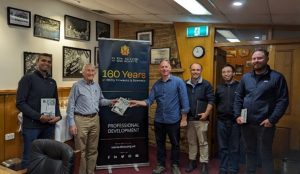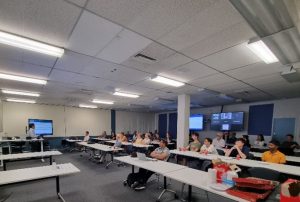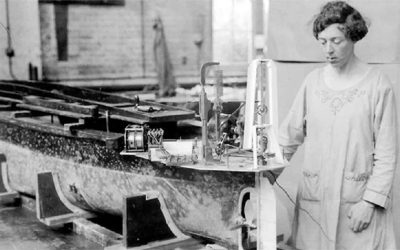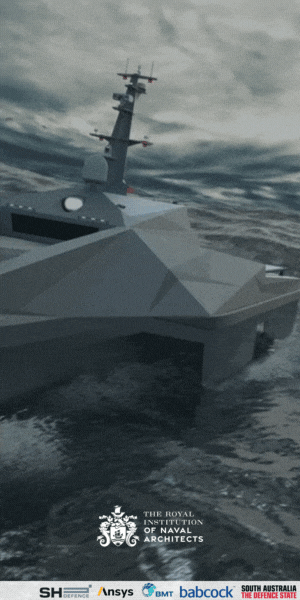Technical Presentation –– 9 April 2024
Michael Stoddart, Researcher, Maritime Museum of Tasmania, gave a presentation on The Blythe Star Tragedy to a meeting at the Royal Yacht Club of Tasmania in Hobart, Zoomed to the Australian Maritime College in Launceston, and streamed live to the wider fraternity on 21 March. The presentation was attended by 8 in Hobart, 6 in Launceston, and a further 10 participating online.
In October 1973 the freighter MV Blythe Star departed from Hobart for King Island with a cargo of fertiliser and beer. The hold was completely filled and outside, on top of the hatch covers, 54 t of palleted fertiliser completed the 351 t cargo. Twelve hours after departure, the ship was logged by Maatsuyker Island at 0515 in the morning. Three hours later, Blythe Star sank in good weather and a calm sea. The crew of ten made it into a life raft but were aghast to learn that the Captain had neither sent out an SOS nor grabbed the portable radio before jumping into the life raft
MV Blythe Star
(Photo from CSIRO website)
Nobody at home knew anything was amiss until 30 hours after the ship’s ETA at Grassy, King Island, had passed, at which time the Marine Operations Centre in Canberra started a search-and-rescue mission. The biggest such operation in Australian history failed to find any trace of the raft. After drifting around the Southern Ocean for eight days, and coming close to a fleet of fishing boats, only to see them turn away, the raft was blown ashore at Deep Glen Bay on the Forestier Peninsula. A few days into their ordeal, the second Engineer died and was buried at sea. Within a few hours of making landfall, the Chief Engineer died, followed a few hours later by the Chief Officer.
After three days of attempted escapes from the Bay the three youngest crewmen knew that if they did not manage to climb the sheer rocky face and find help, then all seven remaining crew would die. Two days of climbing and bush-bashing were rewarded with the arrival of a logging truck which took them to Dunalley, from where the Hobart police were alerted. A helicopter rescued the four crewmen from Deep Glen Bay.
This presentation described the ship’s last journey, its laissez-faire management, and the farcical Court of Marine Inquiry into the loss which ultimately arrived at a conclusion which satisfied no-one.
The presentation was not recorded.
The vote of thanks was proposed, and the “thank you” bottle of Devil’s Corner Pinot presented, by Chris Davies.
The Presenter
Michael Stoddart is a former Chief Scientist of Australia’s Antarctic Program, and is currently a researcher at the Maritime Museum of Tasmania.
(L to R) Nipuna Rajapaksha, Michael Stoddart, Chris Davies,
Michael O’Connor, Gang Zhao, John Polmear
(Photo courtesy Paul Chapman)
Technical Presentation –– 13 March 2024
Hongjun Fan, Postdoctoral Research Fellow at the Australian Maritime College, gave a presentation on The Feasibility of Utilising Hydrogen as a Fuel for Australian Vessels to a meeting at the Australian Maritime College in Launceston, Zoomed to the Royal Yacht Club of Tasmania in Hobart, and streamed live to the wider fraternity on 13 March. The presentation was attended by 29 in Launceston, 4 in Hobart, and a further 19 participating online.
To decarbonise the Australian maritime sector, this presentation examined the viability of adopting hydrogen as a marine fuel. Firstly, an assessment was provided on hydrogen’s potential sustainability, energy security, and affordability in Australia. An analysis of Australia’s domestic vessel fleet structure was conducted, alongside a discussion on how hydrogen can aid in emissions reduction within the fleet. The current state of maritime hydrogen technologies was reviewed, encompassing hydrogen fuel cells, internal combustion engines, hydrogen storage methods, and bunkering technologies.
A case study was presented involving the utilisation of hydrogen on an offshore wind-farm crew-transfer vessel, for which a portable high-pressure storage system and fuel-cell power system were devised. Safety concerns regarding hydrogen leakage were addressed through CFD simulations, with proposed risk-mitigation measures. The technical feasibility study for the vessel identified challenges in storing sufficient energy onboard using current commercially-available compressed hydrogen cylinders. However, effective management of the portable tank supply chain could potentially mitigate this issue through quick tank swapping. The economic feasibility study revealed that the total cost of ownership for hydrogen systems was approximately three times that of diesel systems for the time being.
Finally, emerging technologies such as hydrogen internal combustion engines, cryogenic liquid hydrogen storage, and metal hydride hydrogen storage were discussed, suggesting promising advancements for onboard hydrogen use.
This presentation was recorded and is expected to be available soon on the RINA YouTube channel.
Hongjun Fan making his presentation at the AMC
(Photo courtesy Martin Renilson)
Technical Presentation –– 13 March 2024
Andrew Harris of BMT gave a presentation on A Code of Practice for Aquaculture Vessels to a meeting at the Australian Maritime College in Launceston, Zoomed to the Royal Yacht Club of Tasmania in Hobart, and streamed live to the wider fraternity on 13 March. The presentation was attended by 29 in Launceston, 4 in Hobart, and a further 19 participating online.
This presentation covered the recently-completed two-year project to develop A Code of Practice for Aquaculture Vessels on behalf of the original author, Dr Saeed Mohajernasab, formerly of AMC. This subject was of particular relevance for the Tasmanian audience, with the prevalence of the local salmon-farming industry. The presentation described how the work had been undertaken in three phases:
- a literature survey of existing codes, standards, conventions, and statutory legislation, including an assessment of their relevance to the design and operation of aquaculture vessels;
- a series of interviews with aquaculture operators in Australia and globally; and
- drafting the Code of Practice, with iterations of stakeholder reviews and comments.
The completed code aims to provide operators and purchasers with a convenient guide to addressing aquaculture risk across the range of applicable standards, classification and statutory legislation. Future work is being discussed to establish the body which will adopt and maintain the draft code, as a non-mandatory best-practice document. The assistance and support of the Australian Maritime Safety Authority was gratefully acknowledged.
This presentation was recorded and is expected to be available soon on the RINA YouTube channel.
AMC Careers Fair –– 13 March 2024
The Australian Maritime College held its annual careers fair on Wednesday 13 March. There were over 40 companies represented and it was a very busy event with many students meeting with potential employers. It was also a very useful networking event for those in the industry who attended, with over 80 participants.
The Tasmanian Section of RINA had a stand which was crewed by Martin Renilson and Michael Woodward. The stand was visited by quite a few students, many of whom were interested in knowing how to become chartered through RINA. Others weren’t really aware of RINA, so we took the opportunity to let them know what we do, and encourage them to attend the technical presentations.

